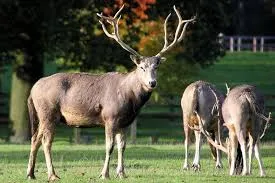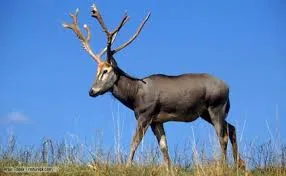The Père David's deer is an extinct wildlife since 2008 and is also known as the milu or elaphur. Scientifically it is called Elaphurus davidianus. It is a species of deer which are mostly found in captivity. This semiaquatic wildlife prefers marshland, and is native to the subtropics of China. It lives mainly on grass and aquatic plants. It is the only extant member of the genus Elaphurus. Regarding genetic comparisons, Père David's deer is nearly related to the deer of the genus Cervus.Which leads many experts to suggest merging Elaphurus into Cervus, or demoting Elaphurus to a subgenus of Cervus.
This species of deer was first discovered in Western science in 1866 by Armand David (Père David), who is a French missionary working in China. He acquired the carcasses of an adult male, an adult female and a young male, and sent them to Paris, where the species was named Père David's Deer by Alphonse Milne-Edwards,who is a French biologist.

The species is also sometimes known to people by its informal name sibuxiang which literally meaning "four not alike", which could mean "the four unlikes" or "like none of the four"; it is differently said that the four are cow, deer, donkey, horse (or) camel. By this name, this undomesticated animal entered into Chinese mythology as the mount of Jiang Ziya in Fengshen Bang that is a Chinese classical work of fiction written during the Ming Dynasty.
The adult Père David's deer has a head-and-body length of up to 1.9–2.2 meters (6.2–7.2 ft) and stands about 1.2 meters (3.9 ft) tall at the shoulder. The tail is relatively long for a deer, measuring 50–66 centimeters (20–26 in) when it remains straightened. Weight is between 135 and 200 kilograms. The head is long and narrow with large eyes, very large preorbital glands, a naked nose pad and small, pointed ears.

To those which generally are living in temperate latitudes, Père David's deer has similar reproductive physiological mechanisms. These mechanisms aid in the adaptation to a high latitude environment. The reproductive behavior in stags differs from hinds. In stags rutting behavior confineds in urine sniffing, anogenital sniffing, wallowing, and antler adorning. Then mating behavior includes mounting and copulating. Again Communication behavior includes the spraying of urine and preorbital gland marking. The stags normally begin to rut prior to any signs of female sexual behavior. The consequent to this is to establish a social rank among the stags.

The Père David's deer has been in isolation from the wild for more than 1200 years, causing humans to be the primary realized threat due to a long-term lack of exposure to other natural predators. When encountering humans, the deer's response varies according to gender.It was hypothesized that the availability of a single type of threat may be sufficient to maintain anti-predator responses in the face of relaxed predation pressure.
Photo credit Google